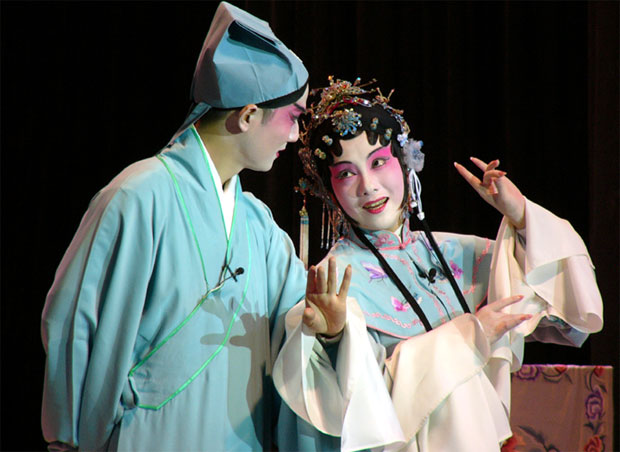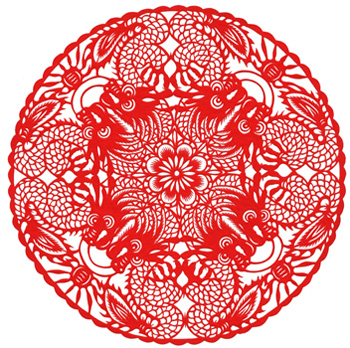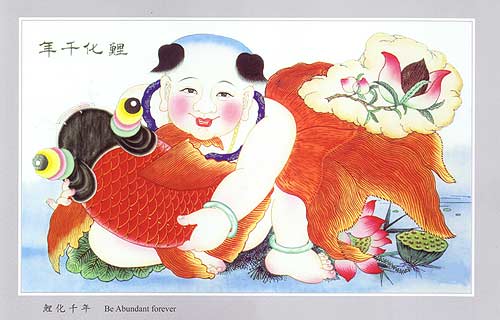The Peony Pavilion
The Peony Pavilion is one of Chinese Classics written by Tang Xianzu in the Ming Dynasty. It is a romantic masterpiece in the Chinese opera history and it is said to be the Eastern version of Romeo & Juliet. The performance tradition has focused on the love story between Du Liniang and Liu Mengmei.
It is the last days of the Southern Song Dynasty when its people still cling to old practices. On a fine spring day, Du Liniang, the sixteen year old daughter of an important official, Du Bao, to abandon her studies and take a walk in the garden, where she falls asleep.
In Du Liniang’s dream she encounters a young scholar, identified later in the play as Liu Mengmei, whom in real life she has never met. Liu’s bold advances starts off a flaming romance between the two and it flourishes rapidly. Du Liniang’s dream is interrupted by a flower petal falling on her Having awakened from her dream, she became lovesick and un-consoled in her longing, until she finally pined away with a broken heart in the seclusion of her maidenly chamber.
Later, Liu takes shelter in Du’s family residence one summer by chance for an examination. In Du’s room, he finds her portrait. Meantime, the president of the underworld adjudicates that a marriage between Du Liniang and Liu Mengmei is predestined and Du Liniang ought to return to the earthly world. The girl comes back to life.
Du Liniang appears to Liu Mengmei in his dreams who now inhabits the same garden where Du Liniang had her fatal dream. Liu agrees to exhume her upon her request and Du Liniang is brought back to life. Liu visits Du Bao, Du Liniang’s father, and informs him of his daughter’s newly resurrection. However, Liu was captured and imprisoned for being a grave robber and an impostor.
The ending of the play follows the formula of many Chinese comedies. Liu Mengmei narrowly escapes death by torture thanks to the arrival of the results of the imperial examination in which Liu has topped the list. The emperor pardons all.
Many people have been moved with the story of Du Liliang.
**************************
The Peony Pavilion is distinguished particularly by the play’s highly refined and subtle lyrics hailed as another height in Chinese literature. Aided by the then newly developed Kun music, the lyrical prose of the Peony Pavillion weave out a dainty fabric of nuances and metaphors which elegantly transgress the divide between nature’s beauty and man’s inner cosmos of emotions and desires.
Through the lights and shadows of the its literary fabric transpire the play’s ravishing sensitivity and intoxicating effeteness and, almost antithetically, a persistent tone of youthful optimism. Within a few words, the audience finds itself, carried by the magic of the play’s language, already in the midst of a celebration of sensitivity, a banquet of metaphors and a dance of the imagination the compound of which defines nothing less than a unique form of and literary and esthetic pleasure.
In 1999, Lincoln Center for the Performing Arts produced a 20 hour version of Tang Xianzu’s Peony Pavilion directed Chen Shizheng.
This 20 hour version was perhaps the first full length staging in 300 years and spurred a renewed interest in the full opera beyond a few celebrated episodes. Lincoln Center’s version toured extensively, playing in New York, Paris, Milan, Singapore, Caen, Charleston, Aarhus, Berlin, Perth and Vienna. DVD highlights have been released in the United States and Taiwan.
In the latest version of The Peony Pavilion, adapted by Bai Xianyong, has once again surprised the world with its breathtaking storyline and the modified, yet preserving costumes that are designed to accommodate the perspective of the modern day viewers. It premiered in 2004 helped rejuvenate this tradition.
Bai Xianyong, a Chinese scholar at the University of California, Working out of the Jiangsu Suzhou Kunqu Theater, the group condensed and adapted the original fifty-five scenes to twenty-seven scenes, and twenty hours of performance time to nine.
He invited over 80 excellent artists from the China’s mainland and Taiwan to form the most powerful team. The actors are not only at their prime time, but also are excellent in appearance, singing and action, very close to the temperament of the figures in the play. The stage pursues the beauty of simplicity so that the play will display the elegance and classicality of the Suzhou ancient culture, and also be full of the charm of youth. The performance was a huge success.
Bai Xianyong, who had chosen The Peony Pavilion because of its universal message of love, hoped that his rendition would attract youth to Kunqu. According to Bai, the goal of this youth-oriented production was to “give new life to the art form, cultivate a new generation of Kunqu, and offer respect to playwright Tang and all the master artists that came before.” His production of The Peony Pavilion was his way of doing so.
Vocabulary
昆曲 kūn qǔ kunqu opera
牡丹亭 mǔ dān tíng The Peony Pavilion
中国文学 zhōng guó wén xué Chinese literature
剧作家 jù zuò jiā Playwright











